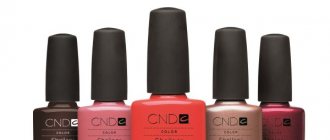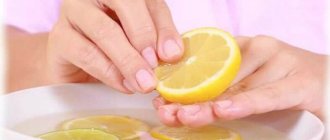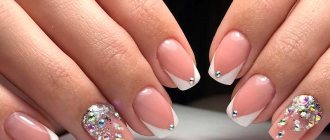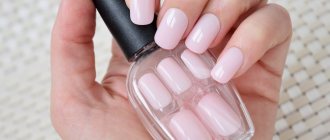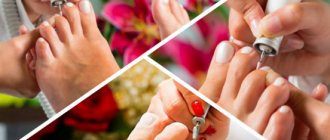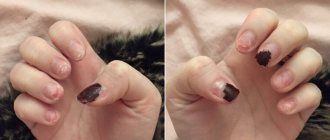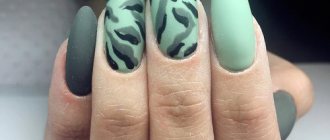A girl’s hands are made to look well-groomed by a neat manicure, so periodically you need to pay attention to visiting the salon to decorate the nail plate. However, the decorative coating is not always of high quality, which is why it can deteriorate prematurely.
Because of this, girls often encounter broken nails under the gel, which is why they don’t know what to do about it, neglecting the recommendations of the master. At such moments, there is a risk of damage to the structure of the natural nail, which affects the further possibility of applying additional coating.
Why do nails peel?
The reasons why nails peel are divided into two categories: internal and external. External ones include:
Mechanical damage
The beauty of your nails is hampered by the use of chemicals without gloves.
These also include hand sanitizers. Another reason why nails peel can be a hobby - for example, drawing. Artists interact with various types of paints and solvents that negatively affect the skin of their hands and nails. Seamstresses and lovers of other needlework also face this problem. And also writers - their nails get damaged from constant interaction with the keyboard.
Permanent gel polish coating
To prevent gel polish from harming your nails, you need to visit manicure salons with professional nail technicians. Otherwise, you may encounter nail injuries that will lead to splitting. For example, damage to the nail plate when filing or trimming the cuticle. You also need to pay attention to the materials. Remember that low-quality products contribute to thinning nails, which leads to brittleness.
Nails peeling due to improper removal of nail polish
Both shellac and home manicure varnishes cause peeling nails if they are not removed correctly.
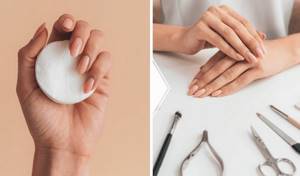
If you have a habit of peeling off pieces of cracked varnish rather than removing the coating using special products, this can lead to delamination. This action removes the polish along with the top layer of the nail plate. Therefore, it is important to use nail polish removers and remove shellac in a salon. You can also remove gel polish at home - for example, using special wipes or the soaking technique.
The internal reasons why fingernails peel are related to our health. This can lead to:
Lack of vitamins
Changes in the structure of nails occur with a lack of vitamins D, B7, A and E.
This often happens with an incorrect diet, when a person does not receive the necessary substances from food. Gastrointestinal diseases can also cause vitamins and minerals to be poorly absorbed.
If there is a lack of vitamins to strengthen nails, it is recommended to adjust your diet by visiting a nutritionist and contact a gastroenterologist to rule out problems with the gastrointestinal tract.
Diseases that cause peeling nails

With pathological processes in the respiratory and cardiovascular systems, fingernails peel, and they also acquire a light blue tint. This is due to impaired blood flow and, as a result, insufficient supply of nutrients to the skin. If this happens, be sure to consult a doctor and have your body examined.
Age-related changes
Thinning of nails occurs as we get older. Nails become more brittle, prone to splitting, and dry cuticles appear. To strengthen nails in this case, various procedures are used both at home and in salons. Read more about this.
How to fix a cracked nail with gel polish
Even if a break occurs under the decorative coating, you can fix it yourself so as not to spoil the result of the manicure, maintaining the healthy condition of your nails.
Required Tools
If, instead of visiting a salon, you decide to restore the manicure effect yourself, first pay attention to the selection of consumables and compositions in order to competently complete the job.
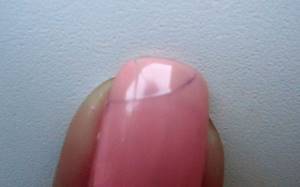
For manipulations you need:
- File;
- Oily hand cream or Vaseline;
- Cotton pads;
- Metal pusher or orange stick;
- Alcohol;
- Foil.
From the compositions, prepare standard solutions for applying gel polish: base, top, color pigments, ultraviolet lamp.
Pre-treat all tools with an antiseptic to prevent infection or dirt from getting under the surface of the nail.
Step by step instructions
Typically, the work takes about an hour or an hour and a half, which depends on the severity of the damage to the nail plate and the dense coating applied by the master.
Work begins by removing the previous coating:
- File off the top layer of the decorative coating.
- Lubricate your finger with rich cream.
- Moisten cotton pads with alcohol and place on the tip of your finger, and wrap a small piece of foil on top.
- After 15 minutes, remove the compress and remove the softened solution using a metal pusher or an orange stick. If the gel adheres strongly to the surface, perform the manipulations again.
Then polish the damaged area and disinfect. Carry out the necessary manipulations to prevent infection under the skin if the crack is large.

To mask damage to the length of the plate, you can put a patch in the form of foil:
- Secure a small piece of foil folded in three times on the nail (to do this, use tape or adhesive tape on the inside). Cover it with primer and place it in the lamp for a minute.
- Cover the nail with foil base to the desired length of the free edge and cure the result again in the lamp. You need to dry twice as long as you usually dry.
- Paint your nails twice with colored gel polish, drying them alternately in a lamp, and then seal the result with top coat. After drying, remove the sticky layer from it using a cotton pad soaked in alcohol.
- Remove the foil; to do this, you can pry it off with tweezers from the inside.
If the manipulations are performed correctly, the nails will be strong and look natural. However, there is no need to grow long nails this way, as they will quickly break. It is worth making small patches with them so that they last until the next manicure correction.
Strengthen your nails with oils
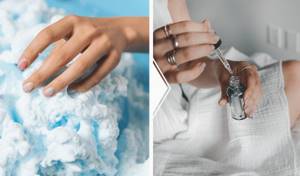
Treatments with olive, castor and burdock oils are especially useful. Plant-based essential oils are effective in strengthening nails. For example, eucalyptus helps maintain the water balance of the nail plate. Rosemary oil relieves inflammation and promotes cuticle healing. By the way, rosemary is known for other beneficial properties.
For compresses, oils are applied to a cotton pad. It needs to be wrapped around the nail. You need to keep this compress for at least 20 minutes, but it is better to do the procedure at night. To do this, you need to wear cosmetic gloves. To remove residual oil, any hand cream will do. The procedure must be repeated at least twice a week.
If your nails are very peeling and you don’t have time for compresses, you can simply rub the oil into the nail plate. This should be done with light massage movements. This procedure can be carried out right at work, without leaving the computer, several times a day.
Another way to strengthen nails is to rub them with oil mixtures. For example, you can take 3 tablespoons of castor, olive and sunflower. If desired and possible, you can supplement this “cocktail” with vitamins A and E from ampoules purchased at the pharmacy. For a volume of 9 tablespoons of oil you need 5 drops of each vitamin.
Building up
If the overgrown part breaks, you cut it off, but want to maintain the length of the manicure, then the only way is extensions. Extensions can be done using top or paper forms, no forms, or using thick material to extend the free edge. It could be a polygel - it holds its shape well and does not spread, but due to its plasticity it can peel off. It can also be a solid gel, such as a jelly gel or a reinforcing gel.
You can also use fiberglass (fiberglass). Fiberglass does not require paper forms to model the shape, so it cannot be called a universal method, but the technique is much faster and easier than the usual one with forms. The technique is also good because the nails look very natural and natural.
The technique is simple: first apply the base, then make blanks from the fibers, evenly rolling the fibers into a thin layer, for example, with an orange stick, then apply gel to the part of the plate where the fibers will be, and then lay out the fibers, sinking them into the gel. The blank is placed overlapping with the growth points with a margin so that the natural nail does not break as it grows. It is important that the blank completely covers the side of the nails - the stiffening rib will strengthen the nails and prevent them from breaking. Next, the fibers are sealed with gel, the excess is trimmed, and the nails are dried.
Important! The obvious and biggest disadvantage of fiberglass is that it cannot be molded into shapes such as pecking tips or upward growing nails, as can be done with paper forms. Therefore, this method is only suitable for straight nails.
Massage your hands regularly
Hand massage helps improve blood circulation. This also has a positive effect on your nails. This is because the skin around them receives more nutrients, which are also useful for strengthening the plate itself. In addition, it is beneficial for skin, which is especially prone to dryness in winter.
Here's how to do a hand massage yourself:
- use cream or oil to make your hands warm up faster - this will improve blood flow;
- rub your brushes: first with light strokes, and then with active circular movements. Start with the wrist area. Then move upward towards your fingertips;
- pay attention to the skin between your fingers - it needs to be squeezed and slightly pulled in the direction of the nails. There should be no pain. Don't pull the skin too hard and let go as soon as it starts to slip out of your fingers;
- massage your hand - to do this, actively walk over it with your thumb, making circular movements;
- To strengthen nails that are peeling, pay special attention to finger massage. First, actively rub them towards your nails. To improve blood circulation to the nail plate, gently squeeze it. To do this, place your finger between the thumb and forefinger of your other hand. You don’t need to press too hard to avoid discomfort, but hold for three to four seconds.
The same thing needs to be repeated, squeezing your finger on the sides of the nail plate.
Broken corners
When a chip occurs at a corner, you can make a sawdust by rounding the ends. But if you want to maintain the square shape, you can use a thick gel to restore the broken corner. In this case, not a polygel, but a thick gel is more suitable, since the first one will fall under the nail and will have to be cut out.
Spread a pea of thick gel with a brush over the area of the chip and pull out the corner. Dry and remove the sticky layer. Next, make a filing to shape the free edge and level the nail with the base.
When your nails peel, do a manicure of minimal length
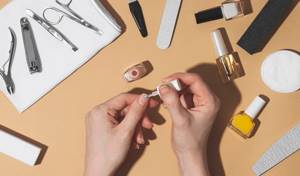
It is better to stick to a short and neat shape without sharp corners. This is explained by the fact that nails that peel are prone to brittleness. And it is much easier for long nails to get caught on something and damage than short ones. Another reason why nails peel off after a manicure of even the minimum length can be an incorrectly selected file. Too hard and abrasive materials injure your nails. Pay attention to glass and ceramic files, but it is better to avoid metal and wooden ones.
Professional help: modeling
There is a list of restrictions for nail extensions. It is better to come to the session with the master with a manicure done three days before. This requirement is explained as follows: a form is placed under the nail, and it is necessary to have at least a minimum free edge for this.
Experienced craftsmen, when asked whether it is possible to repair a nail broken under meat, answer that anything is possible. The specialist decides on the spot which technology to use. You can use top forms, which do not require a free edge, or glue tips used for nail extensions with high pads on the fingers.
The choice of material can also be different: if the nail bed is injured, then the gel will most likely not be suitable due to heating during polymerization. Even with healthy nails there is a burning sensation, but for a wounded finger it is completely painful. Modeling with acrylic is preferable in this case - there is no heating of the material during polymerization.
Use medicinal nail products from the pharmacy
Medicinal nail polishes are sold in pharmacies and contain vitamin and mineral complexes that help strengthen nails. In addition, the transparent coating will additionally protect against mechanical external damage. Colored strengthening varnishes are also produced. So, to care for peeling nails, you don’t have to give up a bright manicure completely.
You also need to remember about the cuticle. To maintain its water balance, there are special serums. They also contain a lot of vitamins and microelements for recovery.
How to protect yourself from breakdowns
To prevent damage that will later have to be repaired, you must:
- study what shape of nails is acceptable in a particular case, so as not to saw through or thin the side parts;
- use a file suitable for their type and work in one direction;
- do not remove the keratinized part of the cuticle with a scraper, as it can easily damage the plate;
- do not put a lot of material on the free edge of the nails;
- eat meat, fish, foods containing vitamins to make the plates stronger.
A broken nail can cause a lot of grief, but this problem can be solved at home. Then it’s still better to go to the master. It has many ways to strengthen your nails. And you can wear a beautiful manicure without waiting for the defect to heal.
Do nail baths daily

Procedures with it can be done on a daily basis. For a glass of warm water you will need a tablespoon of salt. Dip your fingertips into the solution so that it covers the nails completely. The duration of this procedure is from 15 to 20 minutes. Afterwards you can apply a nourishing cream. Please note that salt baths are not recommended if there are injuries on your hands: for example, hangnails or wounds.
Another option for baths to strengthen nails is with herbal decoctions. Use pharmaceutical products from chamomile, mint, linden, oak bark. They are usually sold in the form of filter bags. They need to be poured with boiling water according to the instructions on the package and left to steep for 15-20 minutes. Then the resulting decoction is diluted with boiled water and the procedure is carried out.
Nail extension repair
Extensions are done with acrylic tips . They do not have a living structure, so if they break off, they can be glued with synthetic glue for plastic (superglue, “Moment”). The fastening materials are the same - filter paper, silk strips, paper plaster.
The technology for gluing the extended plate is as follows:
If repairing the extended nail is impossible, you can replace it with a new one.
- Apply glue to the nail and place paper strip on top of it .
Place another drop of glue . the third layer of glue on top of the dried second. - Treat the repair area with a nail file .
- Apply varnish on top .
Another repair option is to replace the broken tip with a new one.
If your nails are peeling, use lemon to restore them.
In order to strengthen the nail plate, you can treat it with lemon juice. It is also useful to keep your nails in its pulp for no more than ten minutes. The effect of lemon treatments is noticeable after 10 days of use.
Lemon not only strengthens, but also whitens the nail plate. It is not necessary to use it in its pure form. You can replace natural fruit with lemon essential oil. Rub a drop of it into each nail.
Another way to use lemon to strengthen your nails is to squeeze a few drops into a salt bath. This will make it even more useful.
Influence of decorative coatings
Why do women's extended nails break? Do your nails break under gel polish or even after regular polish? The reason is the negative impact on the plate of chemical compounds in the coating composition and the mechanical factor.
Nail polishes contain drying components that take away moisture from the nail plate and weaken it. Products containing toluene, formaldehyde, formaldehyde resin, dibutyl phthalate, and camphor greatly dry and irritate nails. Therefore, it is better to choose varnishes with the big5free formula for nail decoration, which do not contain these 5 toxic components. Also, give your nails a rest for at least 5-7 days between coating with decorative varnishes, gel polish or extensions.
Why do nails break after gel polish? In fact, the reason is not in the coating, which gives a bright, long-lasting manicure, but in errors when applying or removing it. They are the ones who provoke brittleness, peeling and cracking of the plate. To avoid this, you need to carefully choose a specialist. This must be a person with education and experience.
Regardless of what decorative coating you are removing, gel polish or regular, do everything correctly and carefully. Do not pull on pieces of polish that have peeled off from the nail plate. Do not try to peel them off, because along with the varnish you risk removing the top layer of the nail. Remove regular varnish using removers without acetone, and remove gel coating or extended nails only with a professional using a hardware method.
Make paraffin baths if your nails are peeling
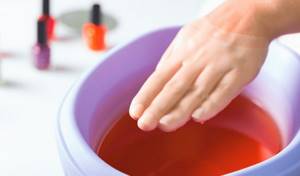
If your nails are peeling, use this procedure from beauty salons. It is distinguished by its effectiveness and natural ingredients. Hands are immersed in special baths with molten paraffin. It retains heat for a long time, thereby improving blood circulation. And the effect of nourishing creams and oils is enhanced when combined with paraffin baths. They are also effective in treating microcracks in nails.
Try sealing your nails
The procedure involves applying wax or biogel to the nails and is carried out by cosmetology specialists. It takes about 40 minutes and can improve the condition of your nails from the first use.
They do it like this: they treat the nail and do a manicure without coating. Then the nail plate is leveled using a fine file. Afterwards, a wax-based product is rubbed into the nail and the procedure is completed by applying nourishing oil.
Since the nail heats up during the sealing process, beneficial substances are absorbed into it better and create a protective film.
There are methods for sealing your nails at home, but we don't recommend it. Incorrect technique can aggravate nail splitting and harm overall nail health.
Broke at the root
It is easy to restore a broken nail yourself using a special kit sold in haberdashery stores or with improvised material.
A prerequisite for repairs is the purchase of:
- quick-drying, special nail glue;
- degreasing and disinfecting solutions;
- nail files;
- buffs.
Among the most popular restoration options:
Using a tea bag
A dry, unused tea bag can serve as a patch, allowing you to maintain the appearance of your manicure.
The photo shows step by step what to do if a nail breaks.
For repair:
Incorporate milk into your home nail care routine
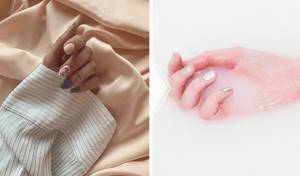
Please note: the fattier the milk, the better. It needs to be heated to a comfortable temperature, hold your fingers in it for 20–30 minutes and wash your hands thoroughly. You can add honey and a few drops of lemon juice to the milk bath. A positive result appears faster if you do the procedure daily.



